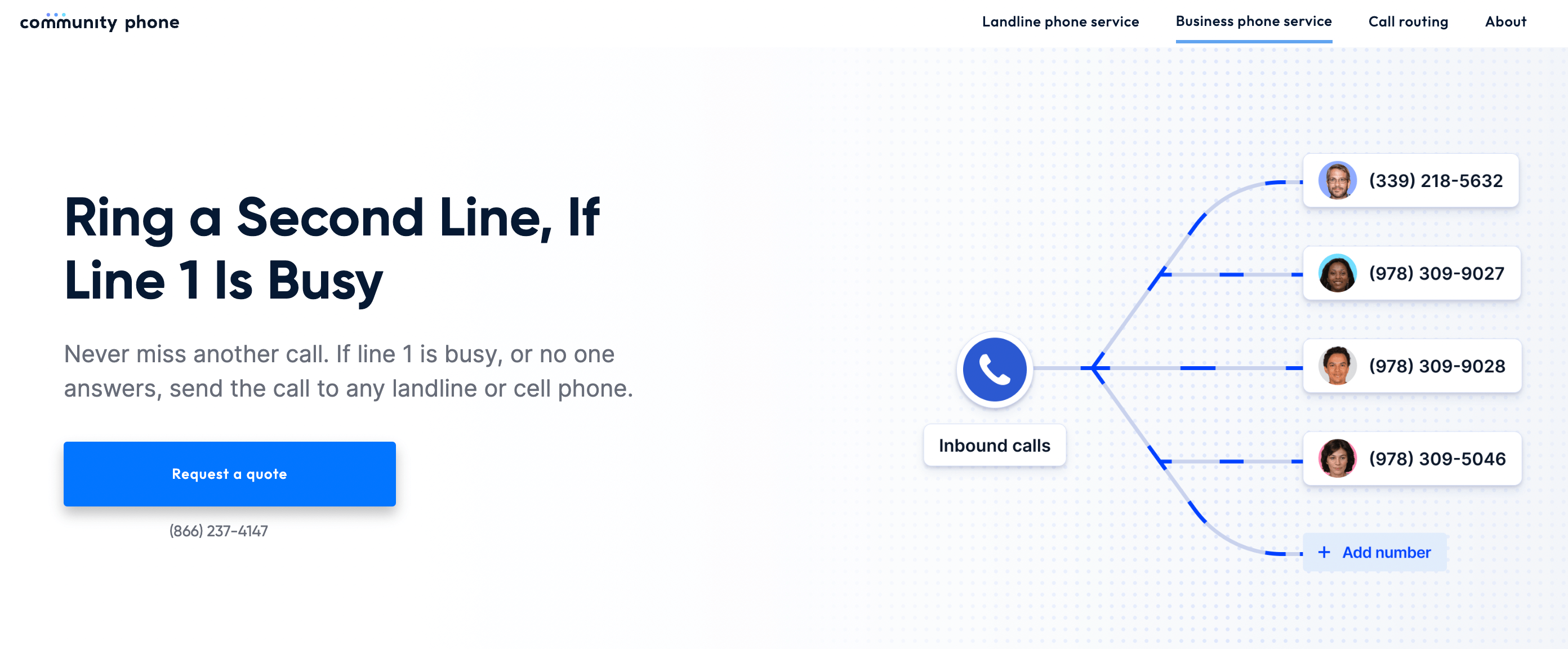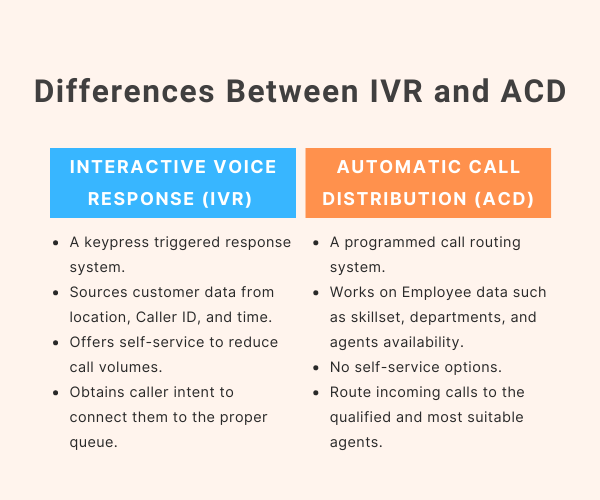People working in a call center know how difficult it is when multiple customers call at the same time. Especially if there are no other agents available to talk to.
Usually, customers are impatient, and rightly so. No one likes to be on hold for hours only to get to the wrong person to deal with the issue.
Automatic Call Distribution systems are now widely used, especially in call centers. It cuts waiting times and puts the customers through the best-skilled agents according to their concerns. ACD optimizes queues and reduces waiting and transferring time resulting in enhanced team effectiveness and increased customer satisfaction.
In this write-up, we are going to discuss What is automatic call distribution and other queries about ACD so that you can take your customer service and sales to the next level.
So, let's dive in!
What is Automatic Call Distribution (ACD)?
ACD — short for automatic call distribution — is a telephony system.
It automatically receives calls and distributes them to available agents. It aims to help inbound call centers manage a large volume of calls to avoid pressurizing the team. It benefits businesses because it improves customer experience by transferring the calls to the right person for the job.
Moreover, it simplifies communication by eliminating the unnecessary transfers where the caller becomes frustrated by talking to several agents to reach the specific department.
For instance, the ACD phone system will directly connect callers trying to reach sales to highly-skilled sales agents. Or when a customer calls for complaints, they will be routed to customer support or complaint department queue.
ACD is based on pre-defined rules according to the company's requirements.
For example, calls coming during after hours or holidays will be directed towards voicemail, while calls from specific numbers will be routed to agents able to assist customers in specific languages.
Features of an Automatic Call Distributor System
ACD helps identify the callers and saves both parties considerable time on redirections.
Some fundamental features of the Automatic Call Distributor system are only suitable for help desk functions. Though, the use of ACD goes beyond just routing callers.
Its features depend on the tool you have chosen. It can even handle complex communications like in a contact center.
Here are the main features of Automatic Call Distribution:
1. Routes Incoming Calls
Automatic Call Distribution works on the company's systematic strategy and corresponding algorithm. The routing strategy considers factors like;
- Caller ID
- Agent's special skills
- Automatic contact identification
- AI-powered providers
With this routing strategy, calls will be easily assigned to the agents with specific skill sets such as language skills, experience, or area of specialization.
There won't be any unnecessary redirections; hence, the customers will be satisfied, and the team will be more productive.
2. Queue Calls
Automatic Call Distributions features ACD queue functionality that reduces the long waiting hours by putting customers on the line with suitable agents. It also helps manage high call volumes and connect customers in the appropriate order.
In addition, it lets you form different call queues for various departments and teams while allowing you to view the queue length so that you can reassign agents and improve workflow management.
Moreover, automatic call distribution has a call-back feature that allows agents to attend the unattended calls. Customers can opt for it, so they don't have to wait in long queues, improving the customer experience.
3. Identify Callers
Call center agents might unknowingly attend to spam calls causing genuine customers to wait longer in the queue. Spam calls hinder the workflow and negatively impact productivity.
ACD is featured to drop the blocklisted numbers from the queue saving agents' time. It can also identify VIP callers and place them at the beginning of the queue.
4. Voicemail Generation
ACD has another feature to reduce the queue and waiting time; it routes calls to voicemail when all agents are busy. This feature allows customers to convey their issues and solve them without waiting readily.
In addition, with the voicemail notifications, voicemail-to-text, and voicemail-to-email, you can ensure these messages don't get lost.
5. Integrates With Other Tools
ACD integrates with other tools to provide better customer satisfaction. It works with:
- IVR - Interactive Voice Response
- CTI - Computer Telephony Integration
- CRM - Customer Relationship Management
With the help of these integrations, ACD increases productivity by automating tasks and assisting agents in accessing data.
Five Benefits of Automatic Call Distribution
Now that you know what ACD is and how it functions let's look at how it can benefit your call center.
1. Enhances Productivity of Call Centers
ACD enhances productivity by eliminating waiting and redirecting time. It routes the call to the specific agent according to their expertise, skills, experience, and training; hence, the agent's productivity will be maximized.
2. Optimized Business Process
ACD doesn't work on incoming and outgoing calls but also allows you to optimize your business process with features like call monitoring and recording. It will give you a better understanding of your team's strengths and weaknesses and how you can work to improve them.
3. Decreases Waiting Queue
ACD directs callers straight to the solutions by routing them to the specific agent, reducing the waiting queues.
4. Great Routing
ACD will take your call center to the next level with excellent routing service. It route calls to specific queues, agents, teams, and extensions. It has a specific algorithm that directs calls based on purpose, priorities, and business hour restrictions.
5. Rapid Priority Call Response
ACD provides rapid response to calls that need immediate action. It puts VIP callers at the beginning of the queue where experts resolve their issues without delay.
How to Use An Automatic Call Distribution System
The Automatic Call Distribution process is summoned into the following steps:
- Callers identification according to predetermined parameters
- Sorting callers into call queues
- Routing calls to specific agents/departments
1. Caller Identification
As mentioned above, the first step of ACD is to identify the caller. Caller ID systems are fed with factors like languages and locations, allowing systems to identify the callers accordingly.
2. Sorting Call Queues
The second step of ACD is to sort the callers into a queue. ACD system determines the order of queue based on:
- Query
- Status
- Waiting time
VIP callers are usually prioritized, but the system is programmed to sort callers based on the factors above.
3. Routing Calls
The last step is routing calls. The ACD will direct the calls based on the distribution method; it routes the callers to the right agent.
Get an ACD System Installed With Community Phone
Community Phone is a different kind of business phone service company. It offers a simple, dependable, affordable home phone service that makes it easy to reach a real person in case of a problem.
The best thing about Community Phone is that it doesn't require fast and reliable internet just for a call, making it a perfect option for call centers.

The main features of Community Phone include:
- It offers unlimited calling minutes across the US.
- Works without internet — no connection or copper wire is needed.
- It features customizable dial menus for business. You can also upload a professionally recorded menu.
- Voicemail transcription and emailing options provide better communication with customers.
- Better call routing.
How Does Community Phone Work?
Community Phone is unique compared to the traditional landline phone providers. It is based on cell phone networks. It works with a Community Phone base device that connects a home phone to a cell phone tower.
The device runs on electricity but is also equipped with a battery to ensure connection during emergencies or power outages.
How to Set up a Community Phone?
Once you receive the device, you can easily set it up within 30-seconds with the following steps.
Step 1:
Plug the Community Phone base into a power outlet.
Step 2:
Connect the phone by plugging it into the jack on the back of the phone base with a cable.
Step 3:
Lastly, let the Community Phone base boot up and start a 30-second setup.
Once it is completed, your phone will be ready to use.
Tip: Make sure that the antennas of your device stand tall.
For a visual explanation, watch the video below:
Read More Here: How to Set Up a Landline
Benefits of Community Phone
Here are the main benefits of Community Phone:
- Super easy-to-install system
- 30-second quick setup
- 12-hour battery to keep it functioning during the power outages.
- User-friendly
- Specially designed for business communications
- It works perfectly without internet or copper wires
Take your call center and business to the next level with Community Phone.
Key Differences Between Interactive Voice Response (IVR) and Automatic Call Distribution (ACD)
IVR and ACD are often used together, so there can be confusion between interactive voice response and automatic call distribution.
Let's take a moment to check out the differences between the two systems:

IVR collects customer data and then hands it off to the ACD. Then, ACD uses it to distribute calls based on agents' skills and availability.
Final Thoughts
You may already have ACD installed in your business, but perhaps it's time to upgrade to more valuable features. Whether you are a business owner or corporate call center owner, Community Phone is the all-in-one home phone phone service to integrate your calls.
From here, you can access many features, including internet-free calling and call routing. It is the perfect solution for those who communicate through a home phone.
Related Posts
